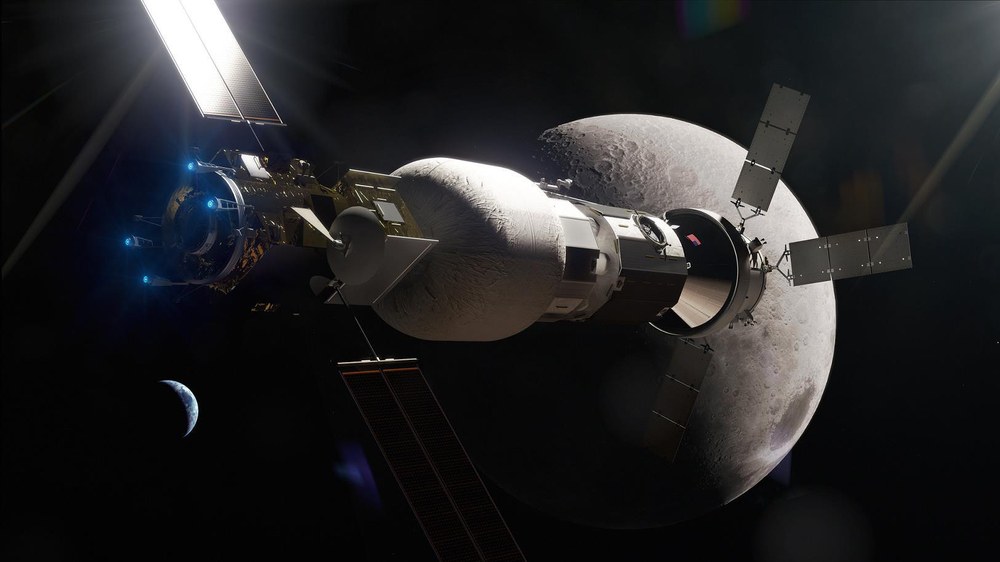'Green light’ for the return to the Moon

- So far, 12 people have set foot on the Moon – all of them NASA astronauts who embarked on their extraordinary journeys between 1969 and 1972 as part of the US space agency's Apollo programme.
- After Apollo comes Artemis, as NASA – 50 years after the last Moon landing – initiates the return to the Moon on 29 August 2022 at 08:33 local time (14:33 CEST) with its new 98-metre-high Space Launch System (SLS) heavy-lift launch vehicle from the Kennedy Space Center in Cape Canaveral (Florida). According to NASA, additional launch windows are possible on 2 September and 5 September 2022.
- Europe, and Germany in particular, are significantly involved in this first test flight through the European Service Module, ESM-1.
- Focus: Human spaceflight, exploration, Moon, international collaboration
+++ Update as of 29 August 2022, 14:34 CEST: NASA aborted the Artemis I launch attempt at approximately 08:34 local time on Aug. 29. The Space Launch System launch vehicle and Orion spacecraft remain in a safe and stable configuration, according to NASA. More information here +++
On 22 August 2022, NASA gave the green light for the first launch window of Artemis I. From a technical point of view, the signs are good for the first flight of the new SLS heavy-lift launch vehicle with the Orion spacecraft on board. The Artemis I mission is scheduled to last 42 days and – if the launch is successful on 29 August – return to Earth on 10 October. The Orion spacecraft, whose service and propulsion module is the European Service Module (ESM), mainly built in Germany, will orbit the Moon several times. The launch will take place from Launch Pad 39B at NASA's Kennedy Space Center in Florida. The Apollo lunar missions also launched from here.
"This is an unprecedented vote of confidence by NASA in the capabilities of our industry and Germany as a partner,” says Walther Pelzer, head of the German Space Agency at DLR and DLR Executive Board member. “We have a 50 percent share in the service modules for the Artemis missions, which are being manufactured by a European industrial consortium under the industrial leadership of Airbus, as ESA's prime contractor, and assembled in Bremen." The first ESM is named ‘Bremen’ after the Hanseatic city.

Return to the moon - Artemis and Germany's participation
Your consent to the storage of data ('cookies') is required for the playback of this video on Youtube.com. You can view and change your current data storage settings at any time under privacy.
The premiere of the ‘return to lunar orbit’ will take place without astronauts. Instead, two measuring mannequins from the German Aerospace Center (Deutsches Zentrum für Luft- und Raumfahrt; DLR) will be on board for the first lunar flight in 50 years. Helga and Zohar will sit in the seats of the future crew and record radiation exposure during the flight. They are part of the Matroshka AstroRad Radiation Experiment (MARE) experiment, led by the DLR Institute of Aerospace Medicine in Cologne.
Orion cannot fly without the service module
The German Space Agency at DLR, based in Bonn, manages Germany's contributions to ESA on behalf of the Federal Government. Germany is currently the largest partner of the European Space Agency, alongside France. Germany is the largest contributor to ESA's exploration programme, which finances the European service modules for NASA's Orion spacecraft. A total of ten ESA member states (Germany and France, as well as Belgium, Denmark, Italy, the Netherlands, Norway, Spain, Sweden and Switzerland) supply parts for the ESM.
Orion cannot fly without the service module. It is the heart of the new spacecraft and sits below the crew capsule. The ESM contains the main engine and supplies electricity via four solar arrays. It also regulates the climate and temperature in the spacecraft and stores fuel, oxygen and water supplies for the crew. The Orion spacecraft, and with it the ESM, is considered a key milestone for future astronautical exploration missions to the Moon, but also to Mars and beyond. NASA has currently ordered six ESMs from ESA, the next of which will be delivered to NASA for the Artemis II mission in early 2023.
"Europe's provision of the ESMs is part of a transatlantic barter. We are thus compensating NASA for the costs of operating and supplying the ISS," explains DLR Executive Board member Walther Pelzer, adding: "I am particularly pleased that the ESM is building on the expertise of the five European ATV transporters and developing it further." The ATV space freighters regularly supplied the International Space Station (ISS) from 2008 to 2015. They were also largely developed and built at Airbus in Bremen.
The second Artemis mission, currently planned for the end of 2023, will be the first to include astronauts. The third mission, Artemis III, will then land the first woman and the next man on the Moon. From 2024 onwards, ESA is to be involved in the Artemis missions to the Lunar Gateway, a small station in lunar orbit, with a total of three places for European astronauts.
The Orion spacecraft
The Orion spacecraft consists of two main parts: the US crew module and the European Service Module. The crew module resembles the capsule shape of the Apollo spacecraft, but is about twice as large. It can hold up to four astronauts, instead of three. The capsule, which weighs around 10 tonnes, also houses the life support system and the flight controls. At the end of a mission, the capsule will re-enter Earth's atmosphere and land in the Pacific, after deploying a parachute. The crew will then be rescued there by ships and helicopters. Fully loaded, the ESM weighs about 15 tonnes at launch. At the end of each mission, the ESM will separate from the Orion capsule and burn up in Earth's atmosphere.


